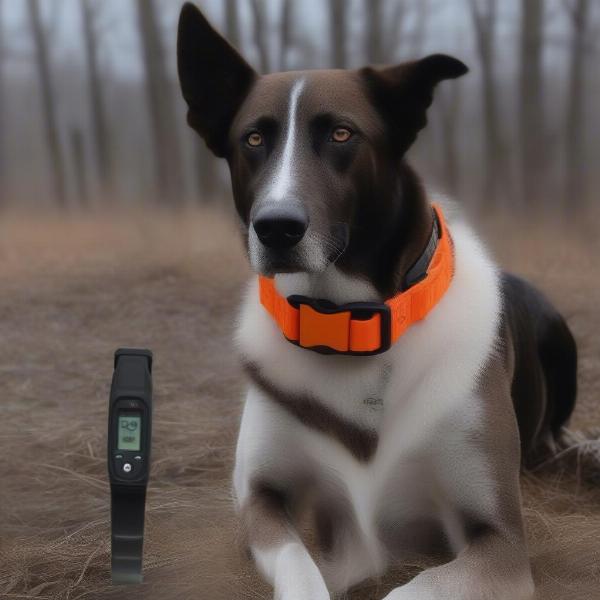Hunting dog collars are an essential piece of gear for any serious hunter and their canine companion. A good collar ensures your dog’s safety and helps you maintain control in challenging environments. This guide will cover everything you need to know about choosing the right hunting dog collar, from basic features to advanced technologies.
Choosing the Right Hunting Dog Collar: Material Matters
When selecting a hunting dog collar, the material is a crucial consideration. Traditional leather collars offer a classic look and are comfortable for long wear, but they can absorb odors and moisture. Nylon webbing is a popular choice due to its durability and water resistance, making it ideal for wet conditions. For the ultimate in performance, consider biothane, a coated webbing that is strong, waterproof, and odor-resistant.
Key Features for a Hunting Dog Collar
 Essential features of a hunting dog collar: High visibility, GPS tracking, and nameplate.
Essential features of a hunting dog collar: High visibility, GPS tracking, and nameplate.
A good hunting dog collar should have several key features. High visibility is essential for tracking your dog in dense cover or low light conditions. Consider bright orange or blaze orange collars. GPS tracking collars offer added peace of mind, allowing you to locate your dog even if they wander out of range. A nameplate with your dog’s name and your contact information is also crucial in case your dog gets lost.
GPS Tracking Collars for Hunting Dogs
GPS tracking collars are becoming increasingly popular among hunters. These collars allow you to monitor your dog’s location in real-time, providing valuable information about their movements and activity. Some GPS collars even offer features like geofencing, which allows you to set virtual boundaries and receive alerts if your dog crosses them.
Durability and Comfort: Striking the Right Balance
The ideal hunting dog collar combines durability with comfort. The collar should be strong enough to withstand the rigors of hunting, but also comfortable enough for your dog to wear for extended periods. Look for collars with padded linings or rounded edges to prevent chafing and irritation.
Sizing Your Hunting Dog Collar
Getting the right fit is essential for your dog’s comfort and safety. A collar that is too tight can restrict breathing, while a collar that is too loose can slip off. Measure your dog’s neck circumference and add a few inches to ensure a comfortable fit.
Expert Tip from Dr. Emily Carter, DVM
“A properly fitted hunting dog collar should allow you to fit two fingers comfortably between the collar and your dog’s neck.”
Specialized Hunting Dog Collars
hunting dog collars with name plates
Different types of hunting require different types of collars. For example, waterfowl hunters might prefer a collar with a built-in handle for retrieving birds from the water. Upland hunters might opt for a duck hunting dog collars with a beeper to help locate their dog in dense cover.
Maintaining Your Hunting Dog Collar
Regular cleaning and maintenance will extend the life of your hunting dog collar. Leather collars should be cleaned with saddle soap and conditioned regularly. Nylon collars can be washed with mild soap and water. Inspect your dog’s collar regularly for signs of wear and tear and replace it if necessary.
Expert Tip from John Miller, Professional Dog Trainer
“A well-maintained hunting dog collar is not only more comfortable for your dog, but also contributes to their safety in the field.”
Conclusion
Choosing the right hunting dog collar is an important decision. By considering the factors discussed in this guide, you can select a collar that meets the specific needs of both you and your hunting companion. Remember to prioritize safety, comfort, and durability when making your choice. dog tracking collar hunting
FAQ
- What is the best material for a hunting dog collar? While leather is classic, nylon and biothane offer greater durability and water resistance for hunting environments.
- Do I need a GPS tracking collar for my hunting dog? GPS collars provide added safety and peace of mind, especially in challenging terrains.
- How do I size a hunting dog collar correctly? Measure your dog’s neck and add a few inches to ensure a comfortable fit.
- How do I clean a hunting dog collar? Leather collars require saddle soap and conditioning, while nylon collars can be washed with mild soap and water.
- What are some specialized hunting dog collars? Waterfowl hunters may prefer collars with handles, while upland hunters might use collars with beepers.
- What features should I look for in a hunting dog collar? Durability, comfort, high visibility, a nameplate, and potentially GPS tracking are key considerations.
- How often should I replace my dog’s hunting collar? Inspect the collar regularly and replace it at the first sign of wear and tear.
About ILM Dog
ILM Dog is your comprehensive resource for all things dog-related. From breed selection and health care to training and nutrition, we provide expert advice and practical tips to help you care for your canine companion. Our expertise in dog products and accessories will help you find the perfect gear for your furry friend. For personalized advice and assistance, contact us at [email protected] or +44 20-3965-8624. We’re here to support you every step of the way.